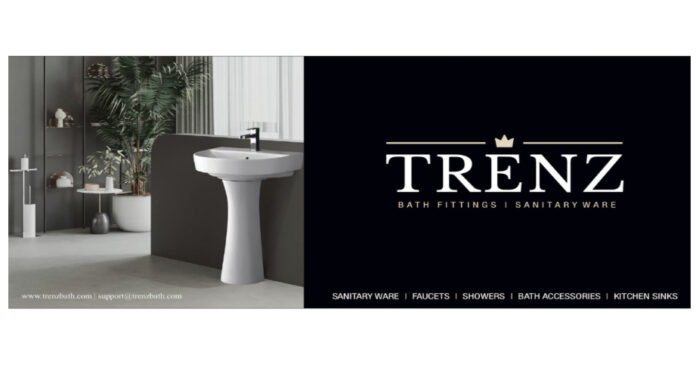Morbi, [India], October 11, 2025: In a category long associated with high markups and exclusivity, TRENZ Bath is advancing a different vision of luxury, one rooted in aesthetic design, functionality, material durability, and pricing that remains within reach for a wider Indian audience. The company manufactures premium bath fittings and sanitary ware with nationwide distribution, serving homeowners, developers, and hospitality projects that want refined aesthetics without the prohibitive cost.
As India’s real estate and home renovation markets continue to boom, the sanitary ware and bath fittings industry is projected to grow significantly, with the overall bath fittings segment alone expected to reach USD 11.49 billion in 2025 and expand at a compound annual growth rate (CAGR) of 7.74% through 2030. Within this, the luxury fittings market is anticipated to hit USD 10.93 billion by 2032, growing at 9.50% CAGR, driven by urbanization and rising middle-class aspirations.
Amid these trends, companies like TRENZ Bath are positioning themselves in the “affordable luxury” niche, aiming to offer high-end designs at more accessible prices. TRENZ Bath’s portfolio spans bath fixtures, sanitary ware, showers, kitchen sinks, and bath accessories (see www.trenzbath.com for details). The common thread across the range is contemporary forms paired with finishes designed to resist corrosion and wear in varied Indian water conditions. Ergonomics, water efficiency, and easy maintenance are designed into the products, reflecting an understanding that true luxury is as much about everyday usability as it is about appearance.
The market, valued at around USD 0.812 billion in 2023 for Sanitary Ware alone, is expected to grow to USD 1.34 billion by 2030 at a 7.38% CAGR, with the organized segment comprising about 60%. This growth is fueled by post-pandemic demand for bathroom upgrades, where spaces are increasingly viewed as wellness areas rather than mere utilities. However, affordability remains a hurdle, with premiumization trends clashing against economic pressures in mid-tier cities.
In this context, TRENZ Bath’s strategy appears timely as the company has outlined plans to diversify into the tiles segment by 2027, with land acquisition currently in progress to support new production facilities. Analysts suggest the strategic rationale is clear: by integrating surfaces with fittings and fixtures, the brand aims to offer cohesive interiors that streamline decision-making for consumers and compress timelines for project professionals. Coordinated palettes, textures, and finishes can reduce complexity and deliver a more unified design language across the space, from faucets and showers to walls and floors.
This direction aligns with how the market is evolving. Bathrooms are increasingly treated as personal sanctuaries rather than purely functional areas, a shift that has accelerated since the pandemic. Industry observations point to shorter renovation cycles and higher per-project spending among mid- to upper-middle-income households. Within this context, the “affordable luxury” segment is widely expected to outpace the overall market, supported by urbanization, rising disposable incomes, and the premiumization trend in residential and hospitality projects. TRENZ Bath’s positioning of premium look and performance at accessible price points, speaks directly to these dynamics.
Similar to trends in the ceramic tiles segment, where Morbi cluster drives efficiency, TRENZ Bath leverages these regional advantages. Operating from Gujarat’s established ceramic and sanitaryware ecosystem, a cluster around Morbi, the company benefits from proximity to raw materials, reliable natural gas infrastructure, and a skilled workforce. These structural advantages contribute to production efficiency and cost competitiveness, critical to sustaining quality at accessible prices. TRENZ Bath’s ISO 9001 certification reinforces customer confidence in a process-led approach to manufacturing and quality control, helping ensure consistency across batches and product lines. However, players like TRENZ Bath also must navigate intense competition from players like Jaquar, Cera,Hindware etc. and supply chain disruptions in raw materials to sustain growth.
Distribution and service complete the equation. Company representatives emphasize that TRENZ Bath maintains a growing network to ensure product availability across India, coupled with transparent warranties and responsive after-sales support. For architects, interior designers, and builders, access to replacement parts and dependable service significantly influence project outcomes and long-term satisfaction. For homeowners, it translates into confidence that the products they choose will perform reliably and be supported over time. Sustainability is increasingly in focus as well. TRENZ Bath is working to embed resource efficiency and responsible sourcing into its operations, with a particular emphasis on durability and water-saving features — two factors that deliver both environmental and cost benefits over a product’s lifecycle.
As the company prepares its tile foray, the benefits could be substantial for both retail and trade customers. A single brand accountable for fittings, sanitary ware, and surfaces can simplify procurement, reduce compatibility concerns, and create visual cohesion throughout the bathroom. For developers and hospitality clients, fewer vendors often mean fewer handoffs, tighter schedules, and more predictable quality. For homeowners, it means easier choices and a finished space that looks considered and complete. TRENZ Bath is positioning itself to deliver a fuller bathroom and interior ecosystem under one trusted label. The move builds on a foundation of design-led products, competitive manufacturing, and a service model aimed at maintaining trust long after installation.
In a crowded market, clarity of proposition matters. TRENZ Bath’s message is straightforward: aesthetic contemporary designs and premium quality, engineered for Indian conditions, at prices that make premium bathrooms more widely attainable. If the company executes its tile expansion with the same focus it brings to fittings and sanitary ware, it is well placed to shape how Indian consumers and professionals alike define—and access—luxury in the bathroom.





















